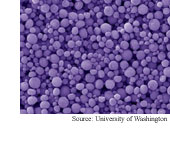|
NEWS
|
Clumps make better solar cells
 Today there are cheap solar cells and there are
efficient solar cells. Making dye-sensitized solar cell
electrodes from nanocrystals clumped into 150- to 400-nanometers
spheres could be a route to making solar cells that are
both cheap and efficient. The technique offers the best
of both worlds: it maintains the high surface area of
nanocrystals needed to hold large amounts of the light-absorbing
dye and at the same time increases light scattering with
the larger spheres, which ups the amount of light that
gets absorbed. (Hierarchically-Structured
ZnO Nanoparticle Film for Dye-Sensitized Solar Cells,
American Chemical Society (ACS) National Meeting, New
Orleans, LA, April 6-10, 2008)
Today there are cheap solar cells and there are
efficient solar cells. Making dye-sensitized solar cell
electrodes from nanocrystals clumped into 150- to 400-nanometers
spheres could be a route to making solar cells that are
both cheap and efficient. The technique offers the best
of both worlds: it maintains the high surface area of
nanocrystals needed to hold large amounts of the light-absorbing
dye and at the same time increases light scattering with
the larger spheres, which ups the amount of light that
gets absorbed. (Hierarchically-Structured
ZnO Nanoparticle Film for Dye-Sensitized Solar Cells,
American Chemical Society (ACS) National Meeting, New
Orleans, LA, April 6-10, 2008)
Digital pet as watchdog
Philip Pullman's science fiction novels are the
inspiration for a potential solution to the problem of
creating secure, practical ways of proving that people
are who they electronically represent themselves to be.
Biometric daemons combine digital authentication tokens
that continuously monitor their owners' biometric data
with electronic pets that owners interact with and care
for. (Biometric
Daemons: Authentication Via Electronic Pets, ACM Computer-Human
Interaction conference (CHI 2008), Florence, Italy, April
5-10, 2008)
Parallel processing of DNA
Reading 280,000 short DNA strands at once and
stitching the results together is a promising technique
for quickly and inexpensively sequencing whole genomes.
The method brings personalized medicine -- using drugs
that are tailored to the individual -- a step closer.
(Single-Molecule
DNA Sequencing of a Viral Genome, Science,
April 4, 2008)
Nanoelectromechanical logic
Computer logic circuits that store 1s and 0s in
the two stable phases of an electromechanical oscillator
-- developed in Japan in the 1950s -- look to be coming
back into fashion, thanks to nanotechnology. Prototype
circuitry made from nanomechanical resonators stores bits
and flips them between 1 and 0. Computers based on the
technology promise to be faster and use less power than
today's computer chips. (Bit
Storage and Bit Flip Operations in an Electromechanical
Oscillator, Nature Nanotechnology, published
online April 13, 2008)
Magnetic memory wires
It's possible to tap the moving boundaries between
magnetic regions in nanowires to store information. The
technology could lead to lower-cost flash memory. A prototype
shift register, which stores and shuttles bits, uses rapid
electric current pulses to write and move bits in about
30 nanoseconds, which is about the same speed as today's
flash memory chips. (Current-Controlled
Magnetic Domain-Wall Nanowire Shift Register, Science,
April 11, 2008)
Tunable terahertz
Metamaterials filter, focus and steer electromagnetic
waves, but they usually work with a narrow range of frequencies
that are determined by the dimensions of the tiny repeated
structures -- typically C-shaped wires -- that make up
the materials. Putting silicon in key places on these
tiny wires makes it possible to use light to tune the
metamaterial's frequency. A prototype that works in the
terahertz range can be changed by about 20 percent. This
could make using terahertz waves for medical imaging and
security scanning more practical. (Experimental
Demonstration of Frequency-Agile Terahertz Metamaterials,
Nature Photonics, published online April 13, 2008) |
FEATURES
|
View
from the High Ground: ICL's John Pendry
Physics as machine tool, negative refractive
index, metamaterials, shattered wine glasses, higher capacity
DVDs, scientific backwaters, risk perception and practice,
practice, practice.
|
How
It Works
Get the nitty-gritty on nanotechnology, biochips, self-assembly,
DNA technologies, quantum cryptography, and more. |
|
 |
News RSS feed 
Blog RSS feed 
Bookshelf RSS feed

New: TRN's
Internet Services
TRN's Jobs Center
|
| |
|
| |
|
| |
"Physics
is to the rest of science what machine tools are
to engineering. A corollary is that science places
power in our hands which can be used for good or
ill. Technology has been abused in this way throughout
the ages from gunpowder to atomic bombs."
- John Pendry, Imperial College London |
|
| |
|
| |
Thanks
to Kevin from
GoldBamboo.com
for technical support |
|

